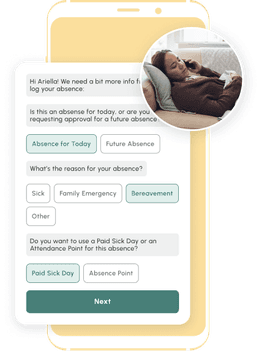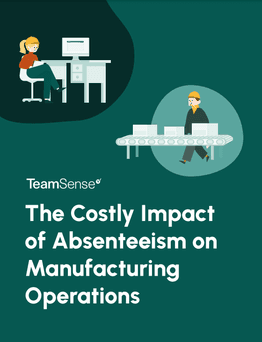Fix the root cause of No-Call No-Show with help from TeamSense
Table of Contents
- The Growing Importance of Automation in HR
- Introduction to Automated Attendance Systems
- Key Features of Automated Attendance Systems
- Benefits of Using Automated Attendance Systems
- How Automated Attendance Systems Transform Employee Management
- Choosing the Right Automated Attendance System
- Popular Solutions in the Market
- TeamSense
- Implementing an Automated Attendance System
- Final Thoughts
How Automated Attendance Systems Change Employee Management
If you feel like you’re playing a never-ending game of "Where's Waldo?" at work, but instead of Waldo, you're tracking employee attendance through a mix of voicemails, he-said-she-said, and endless spreadsheets, it's time for a change. Manually handling employee absence often feels like being stuck in a time loop. Not the most thrilling part of your day, right?
Plus, this chaotic approach not only eats up your valuable time but leaves too much room for error and confusion. Isn’t it about time we ditch the manual madness for something that fits our digital age?
Automated attendance systems can be that breath of fresh air in a stuffy room. They replace the guesswork and manual errors with clear, concise, and real-time tracking. These systems are not just about cutting down on paper; they're about giving you back your time—time you can spend focusing on your team instead of chasing down timesheets. Below, we'll explore how an automated approach to attendance tracking can transform how you manage attendance and breathe a bit of ease into your daily routine.
TL;DR: Executive Summary
- Automated Attendance Systems: Transform the way organizations handle absence reporting with enhanced accuracy, efficiency, and real-time tracking.
- Key Benefits: Reduction in human errors, improved payroll accuracy, enhanced employee accountability, and better compliance with labor laws.
- Strategic Insights: Systems provide valuable data analytics to help manage and optimize workforce efficiency.
- Integration: Seamless integration with existing HR tools enhances overall organizational management.
- TeamSense: Particularly effective for industries with hourly, non-desk workforces, offering text-based absence reporting and real-time data communication.
- Encouragement to Adopt: Transitioning to automated systems offers long-term benefits, boosting employee satisfaction and organizational effectiveness.
The Growing Importance of Automation in HR
Why is automation increasingly essential in HR? It boils down to efficiency, consistency, and employee satisfaction. Automation streamlines HR processes, reducing the burden of repetitive tasks and minimizing human error. Shifting to automated processes not only allows HR teams to focus on more strategic tasks, such as talent management and employee development, but also enhances their ability to provide timely and accurate services to employees.
Automated systems offer a systematic approach to managing diverse HR functions, from recruitment and onboarding to employee performance, evaluations and compliance reporting. This integration ensures that HR practices are consistent across the board, improving fairness and transparency within the organization.
For employees, the impact of automation is equally beneficial. Automated systems provide a straightforward and accessible way to engage with HR services, from updating personal details to managing absences. This ease of use improves the overall employee experience, contributing to higher job satisfaction and engagement.
Specifically for absence management, automation plays a crucial role. It ensures that absence requests are processed swiftly and accurately, reducing delays and misunderstandings. This efficiency not only supports operational continuity but also builds trust as employees see their needs being met promptly and fairly.
Automation in HR is not just about adopting new technology—it's about transforming the HR function into a more dynamic and responsive part of the organization, enhancing both employee satisfaction and organizational effectiveness.
Introduction to Automated Attendance Systems
If you've been waffling about shaking up your absence reporting system, thinking it's just too much hassle to switch things up, now might be the perfect time to dive in. Forget the dread of transition—it’s smoother than you think, and the benefits are worth it.

Overview of Automated Attendance Systems
Automated attendance systems, also known as attendance tracking systems, are the smart upgrade to old-school voicemails and time off request sheets. Instead of manually logging absences, these systems do all the heavy lifting digitally. Employees can report absence via text or an IVR system, and all the data flows into a neat software system that keeps track of everything in real-time.
This shift from manual to digital task management is not just about going paperless—it’s about making your life easier and minimizing all-too-common data errors (ever had an employee claim they left a voicemail but got marked a no call no show… putting you in a pickle?), automated solutions eliminate employee disputes when it comes to attendance.
Key Features of Automated Attendance Systems
Automated attendance systems are loaded with features that not only simplify daily HR tasks but also enhance the overall management of workforce attendance. Let's explore some of these essential features:
Real-Time Tracking
Real-time tracking in automated attendance systems is like having a live feed of who's at work and who's not. As employees log their presence through the system, it updates instantly, allowing both managers and staff to see attendance data as it happens. This immediate insight is crucial for dynamic staffing and helps address issues before they escalate, ensuring that shifts and projects run smoothly.

Automated Notifications
Think of automated notifications as friendly reminders that keep everyone in the loop. These systems send out alerts when employees are absent or late and can even remind staff about their attendance points. This feature is a game-changer for reducing absenteeism and enhancing punctuality.

Attendance Data Analytics and Reporting
One of the most powerful tools of automated attendance systems is their ability to generate reports and turn raw data into actionable insights. With comprehensive analytics and reporting capabilities, HR professionals can track attendance patterns, identify trends in employee data, and pinpoint problem areas. This data-driven approach facilitates informed decision-making, allowing for the optimization of workforce and labor management strategies based on reliable data.

Integration with HR Systems
To truly revolutionize HR management, automated attendance systems often integrate seamlessly with other HR tools, such as with payroll software and employee benefits platforms. This integration creates a unified system that streamlines processes, reduces the likelihood of errors, and enhances the efficiency of data management across various HR functions. The result? A smoother, more cohesive approach to HR that saves time and reduces headaches.
Each of these features brings unique benefits that can transform how businesses manage employee attendance, making daily operations more efficient and helping companies adapt to the fast-paced nature of the modern workplace.

Benefits of Using Automated Attendance Systems
Switching to an automated attendance system isn't just about keeping up with technology—it's about leveraging it to significantly improve your workplace operations. Here’s how these systems are making a difference:
Improved Accuracy
Automated attendance systems dramatically reduce the human errors common in manual time and attendance tracking methods. By automating the entry and tracking process, these systems ensure that attendance records are accurate and reflect actual employee hours worked. This precision is crucial not only for fairness in attendance records but also for payroll processing. When payroll is based on accurate attendance data, it ensures that employees are paid correctly for their time, avoiding overpayments or underpayments that can lead to dissatisfaction and disputes.
Time and Cost Efficiency
One of the most immediate benefits of automated attendance systems is the significant time savings for HR personnel. By reducing the need for manual data entry, cross-checking, and corrections, HR teams can focus on more strategic tasks that benefit the company. Moreover, these systems lower administrative costs associated with managing attendance manually—think of the reduced need for paper records, fewer errors to correct, and less staff time required to manage the processes. Over time, the investment in an automated system can pay for itself through these efficiencies in employee time, and cost reductions.
Enhanced Employee Attendance Accountability
Automated systems bring a new level of transparency to attendance tracking, which naturally fosters a culture of accountability among employees. When workers know that their presence and punctuality are automatically recorded, they are more likely to adhere to their schedules. This transparency not only helps in maintaining operational efficiency but also boosts employee morale by ensuring fair treatment for all regarding attendance. Better attendance habits can lead to improved workplace engagement and a more motivated workforce.
Better Compliance with Labor Laws
Keeping up with labor laws and regulations can be a daunting task, especially when these laws change frequently or differ by location. Automated attendance systems help ensure that businesses comply with relevant labor standards by maintaining precise and auditable records of employee attendance. This same attendance software is particularly valuable for audits or legal scrutiny, as having accurate, easily accessible records can demonstrate compliance efforts and protect businesses against potential fines and legal challenges.
Each of these benefits shows why more and more organizations are turning to automated systems not just to update their processes, but to transform them, making a profound impact on the way they manage their workforce.

No one wants to talk to their boss or a 1-800 stranger to call off. Text changes everything - Reducing No Call No Shows.
How Automated Attendance Systems Transform Employee Management
Automated attendance systems aren't just about keeping track of hours; they're revolutionizing the way we manage employee absences. Let's explore how these tools streamline absence management and foster a healthier workplace environment.
Streamlined Absence Management
Automated systems simplify the complexities of managing absences. They allow managers and HR teams to quickly update and manage schedules based on real-time absence reporting, often through a self service portal. This system’s flexibility is particularly crucial for handling last-minute sick leaves or unexpected absences. By enabling easy adjustments, these systems ensure minimal disruption to daily operations and help maintain workplace harmony.
Proactive Absence Management
Proactive management of employee absences becomes much simpler with automated systems. By analyzing patterns and trends in absence data, these systems help identify potential issues early, such as frequent unplanned absences, which could indicate underlying problems. Managers can use this information to engage with employees proactively, discuss their needs or concerns, and implement strategies to reduce absenteeism. This could include wellness programs, flexible working arrangements, or targeted support, helping to improve attendance rates and reduce turnover.
Enhanced Communication and Transparency
Transparency and communication are the foundations of trust in any workplace. Automated attendance systems enhance this by providing a clear, unbiased record of absences accessible to both employees and managers. This visibility helps avoid misunderstandings and fosters an open dialogue based on mutual trust. Employees appreciate knowing that their records are handled accurately and fairly, while managers benefit from being able to address attendance issues with reliable data.

Choosing the Right Automated Attendance System
Selecting the right automated attendance system for your company is crucial for ensuring effective absence management and overall workforce efficiency. Let’s dive into what you should consider to make the best choice for your organization.
Key Considerations
When selecting an automated attendance system, there are several key factors to consider:
- Features: Look for systems that offer comprehensive tools for tracking absences, generating reports, and sending alerts. Real-time tracking and ease of use are essential for both employees and managers.
- Scalability: The system should be able to grow with your business. Whether you're a small startup or a large corporation, ensure the system can handle your current and future needs.
- Integration: It's important that the new system can seamlessly integrate with your existing HR software. This integration should support data synchronization across platforms to maintain consistency and accuracy.
- Compliance: Ensure the system adheres to legal standards for attendance tracking and data security to protect both your company and its employees.
Choosing a system that aligns with your company's specific needs will not only streamline HR processes but also enhance overall employee productivity and employee satisfaction.
Popular Solutions in the Market
Each system comes with its own set of advantages and challenges, such as cost, complexity, or the degree of customization available. It's important to weigh these factors based on your company's size, budget, and specific HR needs. By carefully considering these aspects, you can choose a solution that not only fits your requirements but also enhances your HR operations.
TeamSense

Description: TeamSense shines in its simplicity and efficiency, offering an absence management solution that caters especially to manufacturing and warehousing teams, or any business environment with hourly, remote, or mobile workforces. Identifying the best attendance tracking software is crucial for your company’s needs, and TeamSense stands out by allowing for a reduction in absenteeism and operational disruptions without the complexity of traditional systems.
Functionality: TeamSense enables employees to track attendance effortlessly via their mobile phones. Absences are reported through a simple text message, bypassing the need for corporate email addresses or complicated applications. An intuitive text-based survey collects the necessary details, and managers receive alerts in real-time, allowing them to respond promptly and effectively.
Communication: The system supports straightforward communication channels that both employees and supervisors can quickly adopt, such as text messaging or IVR (Interactive Voice Response) systems. This accessibility ensures that attendance management is as seamless as possible.
Key Features & Services:
- Text-based call-offs and simple absence survey workflows.
- Automated IVR system for those without smartphone access.
- Engagement surveys and recognition programs to keep morale high.
- A safety check-in feature that allows employees to mark themselves safe during emergencies.
- Self-service access for employees to manage time-off requests or access important documents like handbooks and policies.
- Comprehensive attendance insights and reporting tools to help manage and improve workforce reliability.
- Available in 19 languages, making it versatile for diverse workplaces.

Description: Jibble offers a more technology-forward approach with features like facial recognition and GPS tracking, targeting businesses that need tight security and precise location tracking.
Functionality: It is suitable for businesses with field or remote employees, providing tools to manage attendance through biometric data and mobile device compatibility, allowing employees to clock in and out, manage attendance, and log hours effectively from their smartphones or tablets.
Communication: The system includes advanced security measures to further ensure compliance and the integrity of attendance data, especially in sensitive work environments.
Key Features & Services:
- Facial recognition and GPS location tracking for secure and precise attendance logging.
- Customizable reporting features that cater to diverse business needs.
- Support for both online and offline time tracking.
Timetastic

Description: Timetastic is celebrated for its streamlined approach to leave management, making it an excellent choice for businesses that need a straightforward solution for managing employee absences without the complexities of a full HR suite.
Functionality: The platform specializes in an intuitive leave booking system that integrates well with project management tools, allowing employees to book time off with ease, while managers can approve requests with just a few clicks. The system provides a clear calendar view of who’s off and when, enhancing planning and transparency.
Communication: Timetastic keeps everyone in the loop with automated email and calendar notifications about booked leave, ensuring that all team members are aware of absences without needing to access the system directly.
Key Features & Services:
- Simplified leave booking and management.
- Automated notifications to keep teams informed of upcoming absences.
- A central leave calendar that provides a clear view of all team absences.
- Ability to integrate with popular calendar apps to sync leave with personal or team calendars.
For more options and detailed comparisons of leading automated attendance systems, visit TeamSense’s comprehensive guide on the best absence management systems.
Implementing an Automated Attendance System
Transitioning to an automated attendance system is really not as much of a headache as you may think.
Planning and Preparation
Before jumping into the world of automated attendance systems, start with a solid foundation:
- Stakeholder Involvement: Engage key stakeholders early in the process. This includes not just HR and IT, but also representatives from various departments who will interact with the system daily.
- Clear Objectives: Set specific, measurable goals for what you want the attendance system to achieve. Whether it’s reducing absenteeism, improving payroll accuracy, or enhancing compliance with labor laws, having clear objectives will guide your decision-making and help quantify the system’s success.
- System Selection: Choose a system that aligns with your business size, needs, and the specific challenges you face with attendance management. Consider factors such as usability, integration capabilities, and the level of customer support offered by the provider.
Training and Support
A successful rollout of any new technology relies heavily on the people using it:
- Comprehensive Training: Develop a training program that caters to different learning styles and roles within the organization. Ensure that everyone understands how to use the system effectively, from clocking in and out to reporting absences and accessing their attendance records.
- Support Structures: Implement a support structure that can address technical issues and user concerns promptly. This might include dedicated IT support, HR point persons, and user manuals or FAQs available directly within the system.
Monitoring and Continuous Improvement
To maximize the benefits of your new automated attendance system, continuous monitoring and periodic adjustments are essential:
- Performance Monitoring: Regularly review system performance against the set objectives. This can involve tracking metrics like user adoption rates, reduction in attendance errors, and impact on payroll accuracy.
- Feedback Loop: Encourage feedback from users at all levels. Their insights can highlight unforeseen issues or suggest features that could improve their experience and system efficiency.
- Regular Updates and Training: As the system evolves and new features are added, keep the workforce updated through ongoing training sessions. This ensures that all employees can utilize the system to its full potential.
By taking a structured approach to planning, training, and continuous improvement, businesses can significantly enhance their workforce management practices through automated attendance systems.
Final Thoughts
Automated attendance systems bring significant enhancements to how organizations manage their workforce. Here's a quick recap of the key benefits these systems offer:
- Improved Accuracy and Efficiency: By automating the tracking of absences, these systems reduce human errors and ensure more accurate payroll processing.
- Enhanced Employee Accountability: Real-time tracking promotes a culture of responsibility and can positively impact employee morale and engagement.
- Data-Driven Insights: With comprehensive data analytics, managers can make informed decisions that lead to improved operational efficiency and strategic workforce planning.
- Seamless Integration: These systems often integrate well with other HR tools, creating a cohesive management ecosystem that enhances overall organizational effectiveness.
If you're on the fence about whether or not to implement an automated attendance system, consider the long-term benefits. Not only do these systems streamline administrative tasks and improve accuracy, but they also foster a transparent and accountable workplace environment. Employees benefit from a clear and fair system where their attendance is accurately recorded and managed, leading to higher satisfaction and reduced turnover. For the company, the strategic insights gained from accurate data can lead to better resource management and significant cost savings over time.
Embracing automation in attendance management could be a transformative step for your organization, leading to greater efficiency and a more engaged workforce. Consider making the switch to reap these benefits and position your business for success in an increasingly digital world.

The Costly Impact of Absenteeism on Manufacturing Operations
Learn how chronic, unplanned absenteeism is a costly impediment to manufacturing productivity and efficiency, and how you can reduce absenteeism.
About the Author

Jackie Jones, Employee Engagement & Attendance Specialist
Jackie Jones has over three years of experience helping HR teams improve employee morale, reduce absenteeism, and create happier, more engaged workplaces. With a strong background in employee relations and attendance management, she brings practical strategies and insights that support frontline teams and the HR professionals who lead them.


![15+ Best Absence Management Software [2025]](https://optimise2.assets-servd.host/glib-coyote/production/product/attendanceinsights-full.png?w=345&h=210&q=80&fm=webp&fit=clip&dm=1686851975&s=75a39fa6b9790e8553559529af0e559b)


